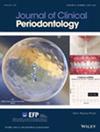糖尿病与种植体周围炎之间的关系:来自瑞典一项基于登记的研究的证据
IF 6.8
1区 医学
Q1 DENTISTRY, ORAL SURGERY & MEDICINE
引用次数: 0
摘要
目的通过一项基于登记的队列研究,评估糖尿病(1型和2型)与种植体周围炎之间的关系。方法使用多个瑞典全国登记系统对四组种植体患者进行鉴定——两组糖尿病患者(1型,T1D; 2型,T2D)和两组非糖尿病患者(非T1D,非T2D)。对2010 - 2020年的纵向数据进行了分析。种植周炎被定义为任何已登记的种植周炎治疗。采用协变量调整logistic回归分析评估种植体周围炎的患病率(n = 18975)。发病率(n = 2030)通过倾向评分通过生存分析比较各组的年龄、性别、教育程度、收入和植入物数量。结果T1D患者的植体炎发生率高于非T1D患者(21.1%比15.2%;OR 1.46, 95% CI: 1.05-2.04),而T2D和非T2D患者的植体炎发生率相似(20.5%比18.2%;OR 1.06, 95% CI: 0.98-1.16)。T1D和T2D发生种植体周围炎的风险比分别为1.52 (95% CI: 0.96-2.42)和1.36 (95% CI: 1.02-1.82)。结论st1d和T2D与种植体周围炎的高风险相关。虽然T1D患者种植体周围炎的风险升高在患病率估计中尤为明显,但T2D的相关性主要体现在发病率方面。本文章由计算机程序翻译,如有差异,请以英文原文为准。
Association Between Diabetes and Peri‐Implantitis: Evidence From a Swedish Register‐Based Study
AimTo evaluate the association between diabetes (types 1 and 2) and peri‐implantitis through a register‐based cohort study.MethodsFour groups of individuals with dental implants were identified using multiple Swedish nationwide registers—two groups with diabetes (type 1, T1D; type 2, T2D) and two groups without diabetes (non‐T1D, non‐T2D). Longitudinal data from 2010 to 2020 were analysed. Peri‐implantitis was defined as any registered treatment of peri‐implantitis. Prevalence of peri‐implantitis (n = 18,975) was evaluated using covariate‐adjusted logistic regression analyses. Incidence (n = 2030) was compared using survival analyses across groups matched by age, gender, education, income and the number of implants, through propensity scores.ResultsPeri‐implantitis was more frequent among those with T1D compared to non‐T1D (21.1% vs. 15.2%; OR 1.46, 95% CI: 1.05–2.04), whereas the prevalence was similar in T2D and non‐T2D (20.5% vs. 18.2%; OR 1.06, 95% CI: 0.98–1.16). The hazard ratios for incident peri‐implantitis were 1.52 (95% CI: 0.96–2.42) and 1.36 (95% CI: 1.02–1.82) for T1D and T2D, respectively.ConclusionsT1D and T2D were associated with a higher risk for peri‐implantitis. While the elevated risk for peri‐implantitis in T1D was particularly apparent in prevalence estimates, the association for T2D was evident mainly in terms of incidence.
求助全文
通过发布文献求助,成功后即可免费获取论文全文。
去求助
来源期刊

Journal of Clinical Periodontology
医学-牙科与口腔外科
CiteScore
13.30
自引率
10.40%
发文量
175
审稿时长
3-8 weeks
期刊介绍:
Journal of Clinical Periodontology was founded by the British, Dutch, French, German, Scandinavian, and Swiss Societies of Periodontology.
The aim of the Journal of Clinical Periodontology is to provide the platform for exchange of scientific and clinical progress in the field of Periodontology and allied disciplines, and to do so at the highest possible level. The Journal also aims to facilitate the application of new scientific knowledge to the daily practice of the concerned disciplines and addresses both practicing clinicians and academics. The Journal is the official publication of the European Federation of Periodontology but wishes to retain its international scope.
The Journal publishes original contributions of high scientific merit in the fields of periodontology and implant dentistry. Its scope encompasses the physiology and pathology of the periodontium, the tissue integration of dental implants, the biology and the modulation of periodontal and alveolar bone healing and regeneration, diagnosis, epidemiology, prevention and therapy of periodontal disease, the clinical aspects of tooth replacement with dental implants, and the comprehensive rehabilitation of the periodontal patient. Review articles by experts on new developments in basic and applied periodontal science and associated dental disciplines, advances in periodontal or implant techniques and procedures, and case reports which illustrate important new information are also welcome.
 求助内容:
求助内容: 应助结果提醒方式:
应助结果提醒方式:


